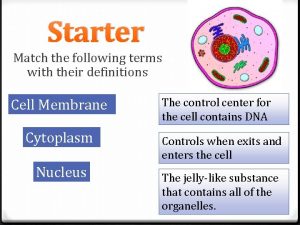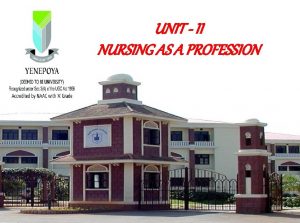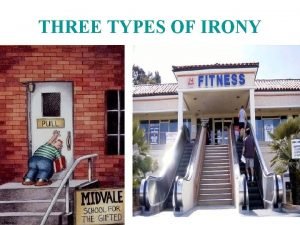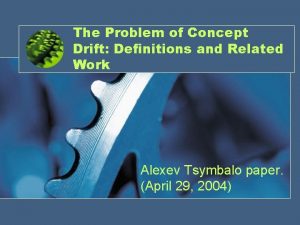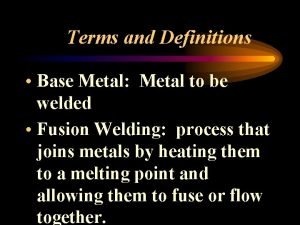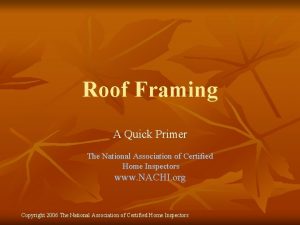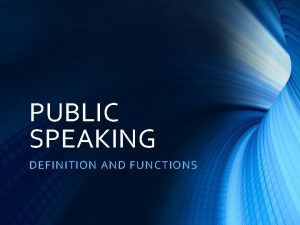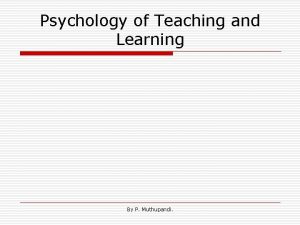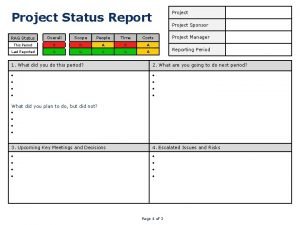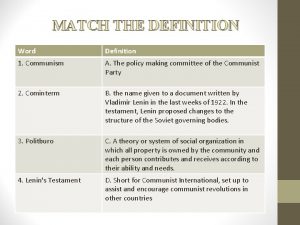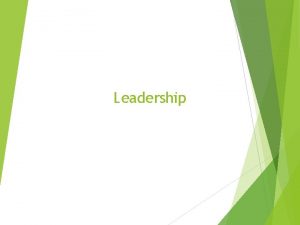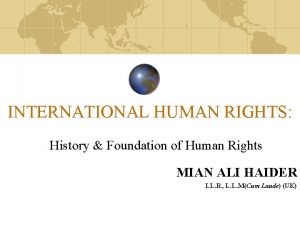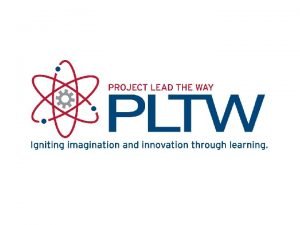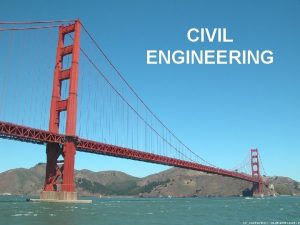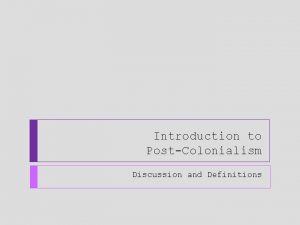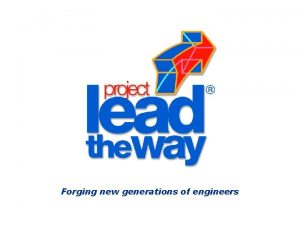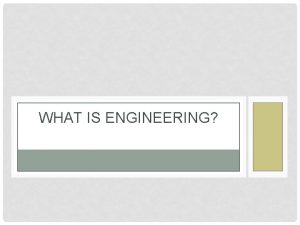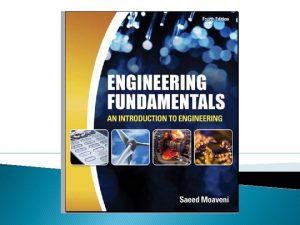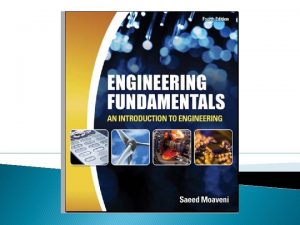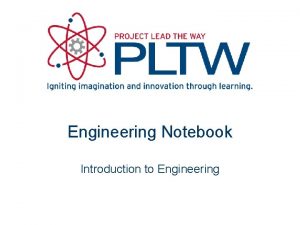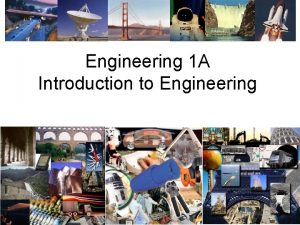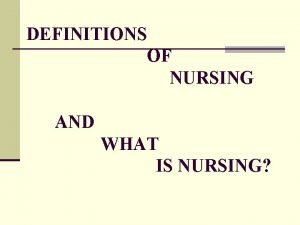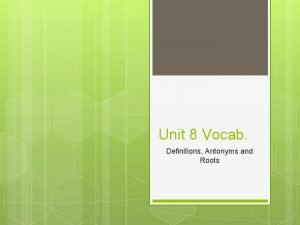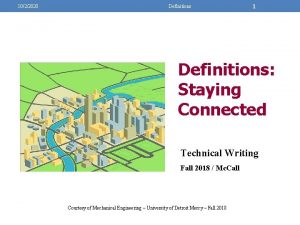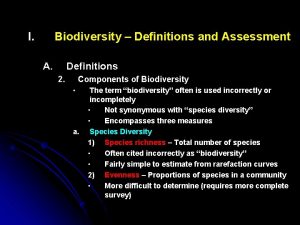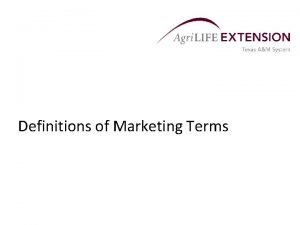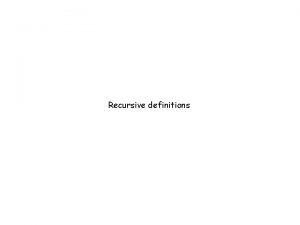Introduction to Engineering l l l l Definitions





















- Slides: 21

Introduction to Engineering l l l l Definitions Technology Team Engineering Disciplines at TAMU Engineering Functions Career Paths ABET Requirements Engineering Profession Back to Today’s ppt

What is Engineering? l The Accreditation Board for Engineering and Technology (ABET) defines engineering: “the profession in which a knowledge of the mathematical and natural sciences gained by study, experience, and practice is applied with judgment to develop ways to utilize, economically, the materials and forces of nature for the benefit of mankind. ” Back to Today’s ppt

What is Engineering? l Engineering is a profession like medicine, law, etc. that aspires to high standards of conduct and recognizes its responsibility to the general public. Back to Today’s ppt

Technology Team l l Scientist - Like an engineer, but a primary goal is the expansion of knowledge and understanding physical processes. Engineer - Applies knowledge of math and the physical sciences to the efficient design and construction of usable devices, structures and processes. Back to Today’s ppt

Technology Team l Technologist - Technologists focus on direct application of established engineering principles and processes. Math, the physical sciences, and underlying engineering theory receive limited coverage. More interested in hardware and processes. Back to Today’s ppt

Technology Team l l Technician - Completes a 2 year degree in a narrow technical area such as electronics, drafting, or machining. Artisans - Training may be a combination of schooling and work experience. Examples include, welders, machinists, electricians, carpenters, painters, steel workers, and artists. Back to Today’s ppt

Engineering Disciplines at TAMU l l Aerospace Agricultural Chemical Civil l Environmental Ocean Computer Science and Computer Engineering Back to Today’s ppt

Engineering Disciplines at TAMU l l l Electrical and Computer Engineering Technology and Industrial Distribution Industrial l l Biomedical Mechanical Nuclear and Radiological Health Safety Petroleum Back to Today’s ppt

Engineering Degrees Awarded by Discipline in 1993 -94. (64, 946 degrees awarded) Back to Today’s ppt

Engineering Functions The focus of an engineer’s work typically falls into one or more of the following areas: l Research - explore, discover and apply new principles l Development - transform ideas or concepts into production processes l Design - link the generation of ideas and the production Back to Today’s ppt

Engineering Functions l l Production and testing - manufacture and assemble components or products Sales - market engineering products Operations - maintain equipment and facilities Construction - prior to construction organizes bids, during construction supervises certain components of process Back to Today’s ppt

Engineering Functions l l l Management - optimize the use of resources (equipment, labor, finances) Education - teach engineering principles in university and industrial settings Consulting - provide specialized engineering services the clients. May work alone or in partnership other engineers. Back to Today’s ppt

Who employs engineers? Percentages of Employed Engineers by Major Fields and Sector of Employment (Based on 1988 data from Wright) Back to Today’s ppt

Career Paths for Engineers There at least seven career options for graduating engineering students: 1) Corporate ladder 2) Independent entrepreneur 3) Military or government 4) Engineering and social service aboard 5) Professor/engineer 6) Graduate work outside engineering 7) A mix of first six options Back to Today’s ppt

ABET Engineering Curricula Four year engineering programs approved by The Accreditation Board for Engineering and Technology (ABET) includes a broad range of courses. Back to Today’s ppt

Why do I care about ABET accreditation? l l l ABET audits engineering programs on a regular basis to assure that the program maintains high standards. Having an engineering degree from a four-year accredited engineering program is required to become a registered professional engineer. All degree programs in the College of Engineering at TAMU are accredited by ABET Back to Today’s ppt

Engineering as a Profession l l l Engineering possesses those attributes that typically characterize a profession: Satisfies an indispensable and beneficial need. Requires the exercise of discretion and judgment and is not subject to standardization. Back to Today’s ppt

Engineering as a Profession l l l Involves activities that require knowledge and skill not commonly possessed by the general public. Has group consciousness for the promotion of knowledge and professional ideas and for rendering social services. Has a legal status and requires well-formulated standards of admission. Back to Today’s ppt

Professional Registration Six steps are typically required to become a registered professional engineer 1. Graduate from an ABET approved (4 year) engineering curriculum. 2. Pass the fundamentals exam (FE) or (EIT) engineer in training exam in their last term or after graduation. Back to Today’s ppt

Professional Registration 3. Complete a minimum of four years of engineering practice 4. Obtain letters of references and approval to take PPE 5. Pass the Professional Exam (PE) or the Principals and Practice Exam (PPE) 6. Apply to individual states for professional license. Back to Today’s ppt

Professional Organization Student Chapters l l l Every engineering discipline at TAMU has a student chapter for its professional society Contact your department for more information You are highly encouraged to get involved with your student chapter Back to Today’s ppt
 Match the following terms and definitions.
Match the following terms and definitions. What is system in software engineering
What is system in software engineering Forward engineering and reverse engineering
Forward engineering and reverse engineering Engineering elegant systems: theory of systems engineering
Engineering elegant systems: theory of systems engineering Engineering elegant systems: theory of systems engineering
Engineering elegant systems: theory of systems engineering Forward and reverse engineering
Forward and reverse engineering Who definition of nursing
Who definition of nursing What is verbal irony
What is verbal irony The problem of concept drift: definitions and related work
The problem of concept drift: definitions and related work The correct shutoff procedure for an oxyacetylene torch is:
The correct shutoff procedure for an oxyacetylene torch is: How to measure for birdsmouth cut
How to measure for birdsmouth cut Types of goniometer
Types of goniometer Speech to actuate definition
Speech to actuate definition What is the meaning of
What is the meaning of Rag status definitions
Rag status definitions Poverty definitions
Poverty definitions Non verbal communication definition
Non verbal communication definition Micro teach meaning
Micro teach meaning Revision materials
Revision materials Match the following terms with their definitions communism
Match the following terms with their definitions communism Leadership and management definition
Leadership and management definition What are fundamental rights
What are fundamental rights
